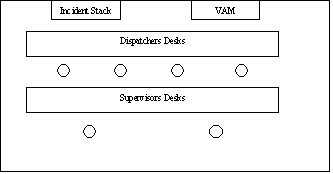
Small group of workers (4 dispatchers and 2 supervisors), Location within a site with co-location at desks. Ability to oversee and overhear one another. Focus on the collaborative techniques personnel use to achieve ambulance management and deployment.
Teamwork per se is not represented either on documents or on the system. However, the outcomes of teamwork are represented in the changing details of screens showing details of incidents (the incident stack), ambulances and the configuration of ambulances over the region as a whole (the VAM).

The close arrangement of dispatchers and supervisors means that the can oversee and overhear one anothers activity, interaction on the phone, with others and with applications. This promotes that ability to help one another out and collaborate when required.
Workers collaborate in an ad hoc manner, if and when required. Workers may carry out tasks for one another or collaborate together on solving problems through collaborative groups of varying sizes. Teamwork activities may be initiated through seeing someone requires help but are commonly worked up through talk. Workers can also be seen to negotiate who is available to help, who has expertise and so forth. The collaboration is worked up in response to a particular situation and ends once the task in question has been solved.
Inter-organisational group of workers (4 dispatchers and 2 supervisors) in an ambulance control room.